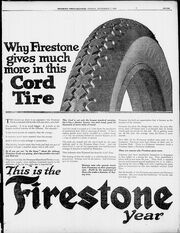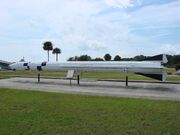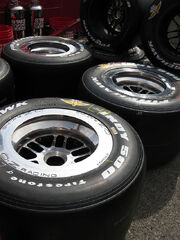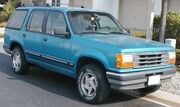
| Firestone Tire and Rubber Company | |
|---|---|
| {{{Marque}}} | |
| aka | {{{aka}}} |
| Production | {{{Production}}} |
| Class | {{{Class}}} |
| Body Style | {{{Body Style}}} |
| Length | {{{Length}}} |
| Width | {{{Width}}} |
| Height | {{{Height}}} |
| Wheelbase | {{{Wheelbase}}} |
| Weight | {{{Weight}}} |
| Transmission | {{{Transmission}}} |
| Engine | {{{Engine}}} |
| Power | {{{Power}}} |
| Similar | {{{Similar}}} |
| Designer | {{{Designer}}} |
The Firestone Tire and Rubber Company is an American tire company founded by Harvey Samuel Firestone in 1900 to supply pneumatic tires for wagons, buggies, and other forms of wheeled transportation common in the era. Firestone soon saw the huge potential for marketing tires for automobiles. The company was a pioneer in the mass production of tires. Harvey Firestone had a friendship with Henry Ford. Firestone used this relationship to become the original equipment supplier of Ford Motor Company automobiles, and was also active in the replacement market.[1]
In 1988, the company was sold to the Japanese Bridgestone Corporation.
History[]
Early/mid 20th century[]

The First Firestone store

Firestone newspaper ad from 1919, explaining the benefits of their cord tire.
Firestone was originally based in Akron, Ohio, also the hometown of its archrival, Goodyear Tire and Rubber Company, and another two mid-sized competitors, General Tire and Rubber and BF Goodrich. Founded on August 3, 1900,[2] the company initiated operations with 12 employees.[3] Together, Firestone and Goodyear were the largest suppliers of automotive tires in North America for over 75 years. In 1906 Henry Ford chose Firestone for Model T original equipment tires.[4]
In 1918, Firestone Tire and Rubber Company of Canada was incorporated in Hamilton, Ontario and in 1922, the first Canadian-made tire rolled off the line on September 15.[5] During the '20s, Firestone produced the Oldfield tire, named for racing driver Barney Oldfield.
In 1926, the company opened one of the world's biggest rubber plantations in Liberia, West Africa, spanning more than 1 million acres. 1926 was also the year that the company opened its first Firestone Complete Auto Care store (Firestone Complete Auto Care is a division of Firestone that offers automotive maintenance and repair).
The company sponsored The Voice of Firestone on the radio beginning on December 1928. The program was transferred to television as an NBC simulcast on 5 September 1949. The last broadcast was in 1963.[6]
In 1928 the company built a factory in Brentford, England, a longtime Art Deco landmark on a major route into the city. This closed in 1979.
In 1936 the company opened a plant in Memphis, Tennessee. With a work force exceeding 3,000 employees, the Memphis plant was the largest tire manufacturer in the company’s worldwide operation. On July 1, 1963, the company celebrated the production of 100 million tires in Memphis.[7] The plant was closed in 1982.[8]
During World War II the company was called on by the U.S. Government to make artillery shells, aluminum kegs for food transport and rubberized military products. Firestone ranked 55th among United States corporations in the value of World War II military production contracts.[9] In the 1940s, Firestone was given a defense contract to produce plastic helmet liners. While outproduced by Westinghouse Electric they still made a fair amount for the M1 Helmet.

Corporal Missile
In 1951, Firestone was given the defense contract for the MGM-5 Corporal missile. Firestone was given a total of US$6,888,796 for the first 200 Missiles. This missile was known as the "Embryo of the Army" and was a surface-to-surface guided missile which could deliver a high explosive warhead up to Template:Convert/nmi. It was later modified to be able to carry a nuclear payload for use in the event of Cold War hostilities in Eastern Europe. This missile was replaced in 1962 by the MGM-29 Sergeant system.[10]
In 1961, Firestone acquired the Dayton Tire division from the Dayco Corporation.
Restructuring and sale to Bridgestone[]

Firestone operates a chain of repair shops which perform maintenance on cars. A service representative in Berkeley Heights, New Jersey.
In late 1979, Firestone brought in John Nevin, the ex-head of Zenith Electronics, as president to save the hemorrhaging company from total collapse. It was more than a billion dollars in debt at the time, and losing 250 million dollars a year. Nevin closed nine of the company's seventeen manufacturing plants, including six in one day. He moved the company from its ancestral home in Akron to Chicago. He spun off non-tire related businesses, including the Firestone Country Club. It was considered a deliberate plan to boost the stock price, and it paid off. In 1988 after discussions with Pirelli, Nevin negotiated the sale of the company to the Japanese company Bridgestone. Bridgestone Corporation Japan was able to buy the company for much less than it had been worth a decade and a half earlier.[11][12][13] The combined Bridgestone / Firestone North American operations are now based in Nashville, Tennessee. In 2008 the companies celebrated a 20 year anniversary of the merger, and changed the tire division name to Bridgestone Americas Tire Operations, LLC. In 2012, Bridgestone Americas opened a $100 million technical center in Akron.

Firestone tires used for the Indianapolis 500 race.
Apart from tires, several companies and divisions operate with the Firestone brand in its name. These companies include Firestone Building Products, LLC, Firestone Industrial Products, LLC, Firestone Complete Auto Care, Firestone Natural Rubber Company and Firestone Specialty Products. Firestone Building Products and Firestone Industrial Products are headquartered in Indianapolis, Indiana and operates in 23 U.S. states and ten countries, with 11,000 employees worldwide. The company reports annual sales of more than $2.5 billion.[14]
In 1972 Firestone received a ten-year import "concession" by the Kenyan government to secure Firestone's investment in a domestic tire plant, which gave it a virtual monopoly.[15] This included both general price and foreign exchange controls.[16] When the ten-year period came to an end in 1979, Firestone retaliated by increasing production, making entry less attractive.[15] Headquarters eventually canceled expansion and failed negotiations lead to no further investments.[16]
In motorsport[]
The 1911 Indianapolis 500 auto race was won by a car running Firestone tires. Firestone-shod cars won all editions of the race from 1920 to 1966. The company also provided tires to Formula One from 1950 to 1974. As a consequence of the 1973 Indianapolis 500, 1973 United States Grand Prix and 1974 Austrian Grand Prix tragedies, Firestone retired from American open-wheel racing and Formula One after 1974. The manufacturer returned in 1995 to the CART series with technical assistance from Bridgestone. Goodyear retired after 1999, thereby leaving Firestone as the single supplier of the IndyCar Series as of 2013.
Corporate troubles[]
Great American streetcar scandal[]
In 1950, Firestone along with General Motors and Standard Oil were charged and convicted of criminal conspiracy for their part in the Great American streetcar scandal. The scandal included purchasing streetcar systems throughout the United States and dismantling and replacing them with buses.[17]
Firestone 500 tread separation problem[]
Radial tires were introduced to the US market by rivals Goodrich and Michelin in the late 1960s, and Firestone lacked their own product line. The first radial tire developed and produced by Firestone was the ill-fated Firestone 500 Radial. Manufacturing of the new tire was performed on equipment designed to manufacture bias-ply tires.
During the 1970s, Firestone experienced major problems with the Firestone 500 radial. The Firestone 500 steel-belted radials began to show signs of separation of the tread at high speeds. While the cause was never proved, it is believed that the failure of bonding cements, used by Firestone to hold the tread to the tire carcass, may have allowed water to penetrate the tire which in turn may have caused the internal steel wire to corrode. In March 1978, the U.S. National Highway Traffic Safety Administration (NHTSA) announced publicly a formal investigation into defects of the Firestone 500. The NHTSA investigation found that the tread separation problem was most probably a design defect affecting all Firestone 500's.
In 1973, only two years after the 500's debut, Thomas A. Robertson, Firestone's director of development wrote an internal memo stating "We are making an inferior quality radial tire which will subject us to belt-edge separation at high mileage".[18] Firestone introduced strict quality control measures in an attempt to fix the inherent problems, however they were not successful in totally eliminating the basic faults. In 1977 a recall of 400,000 tires produced at the problematic Decatur, Illinois plant was initiated. Firestone was considered to be less than cooperative with the NHTSA during the agency's investigation into the Firestone 500. Firestone blamed the problems on the consumer, stating underinflation and poor maintenance.
On October 20, 1978, Firestone recalled over 7 million Firestone 500 tires,[19] the largest tire recall to date. Congressional hearings into the 500 also took place in 1978. The tire was found to be defective and the cause of 250 deaths. In May 1980 after finding that they knew the tires were defective, the NHTSA fined Firestone $500,000 USD, which at that time was the largest fine imposed on any U.S. corporation and the largest civil penalty imposed since passage of the 1966 National Traffic and Motor Vehicle Act. Multiple lawsuits were settled out of court and the constant negative publicity crippled the company's sales and share price.[20]
Harvard Business School and Wharton School taught classes and wrote papers on the issues of misjudgments and poor decision making by the management of Firestone.[20][21] After years of bad publicity and millions paid out in compensation to victims, Firestone was losing vast amounts of money, and its name was severely damaged.[22][23][24][25]
Liberian rubber plantation[]

Latex collection
- Main article: Firestone Natural Rubber Company
Firestone established the Firestone Natural Rubber plantation in Harbel, Liberia in 1926. From 1926 until 1990 at the outbreak of the First Liberian Civil War, the Firestone Natural Rubber Company was the largest plantation of its kind in the world.[26] In 1990, the rebel army NPFL (led by convicted war criminal Charles Taylor) executed Liberian dictator Samuel Doe[27] and invaded and occupied the Harbel plantation.[26] As a result of this occupation, Firestone evacuated its American workers. In June 1991, Firestone sent a delegation to Monrovia in an attempt to re-start operations in Harbel.[28] After a month of waiting, the delegation was brought to meet Taylor, and after a further six months of negotiations the company signed a Memorandum of Understanding (MOU) with the National Patriotic Reconstruction Assembly Government’s Ministry of Finance in January 1991.[29] This MOU provided for taxes to be paid by Firestone to the Taylor government, and for the Taylor government to provide protection to Firestone’s employees and assets in Liberia. Firestone restarted operations in March 1992, but once again had to halt in October that same year, as the violence of the war escalated.[30] Over this period, the company had paid $2.3m in taxes to the Taylor government, which some say helped legitimize Taylor’s Greater Liberia government and finance and enable its attack on ECOMOG controlled Monrovia.[31] Operations did not fully restart until 2003 at the conclusion of the Second Liberian Civil War. Since the end of the war, Firestone has invested over $100m[32] in restoring and rebuilding its operations in Liberia.
The company’s operations in Liberia have been the subject of considerable scrutiny and criticism, including a 2005 Alien Tort Claims Act case[33] brought in California by the International Labor Rights Fund and a 2014 investigative report by ProPublica entitled “Firestone and the Warlord,[34]” and a PBS Frontline documentary by the same name.[35]
Ford Explorer rollover problem[]
- Main article: Firestone and Ford tire controversy
In 1996, several state agencies in Arizona began having major problems with Firestone tires on Explorers. According to news reports, various agencies demanded new tires, and Firestone conducted an investigation of the complaints, tested the tires and asserted that the tires had been abused or under-inflated.
On September 6, 2000, in a statement before the US Senate Appropriations Transportation subcommittee the president of the consumer advocacy group Public Citizen, Joan Claybrook, stated:
<templatestyles src="Template:Blockquote/styles.css" />
...There are a number of parallels between this recall in 2000 and the 1978 recall of the Firestone 500....there was a documented coverup by Firestone of the 500 defect, spurred by the lack of a Firestone replacement tire. When the coverup was disclosed, the top management of the company was replaced as Firestone was severely damaged in reputation and economically. But a key difference is that the Firestone 500 was used on passenger cars, which rarely rolled over with tire failure. NHTSA documented 41 deaths with the 500, a recall, involving seven million tires.[36]
The report went on to indicate that Ford also had a major role in the problems stating that The Ford Motor Company had instructed Firestone to add a nylon ply to the tires it manufactured in Venezuela for additional strength and that Ford had made suspension changes to the Explorer model available in Venezuela. Ford did not specify adding the nylon ply for U.S.-made Firestone tires nor did it change the Explorer suspension on US models at this time.

Ford Explorer
An abnormally high failure rate in Firestone's Wilderness AT, Firestone ATX, and ATX II tires resulted in multiple lawsuits, as well as an eventual mandatory recall. In 2001 Bridgestone/Firestone severed its ties to Ford citing a lack of trust. The lack of trust stemmed from concerns that Ford had not heeded warnings by Bridgestone/Firestone relating to the design of the Ford Explorer.[37] In 2006, Firestone announced renewed efforts to recall tires of the same model recalled in 2000 after the tires were linked to recent deaths and injuries. According to Firestone's last filing with the National Highway Transportation Administration, only 90,259 of more than 2.5 million recalled tires were confirmed as removed from service.[38] In November 2013, two recalled Wilderness AT tires were found in Atlanta, Georgia.[39] One of the tires was offered for sale as new at a used tire retail shop.[39]
Television advertisement jingle[]

Early Firestone Advertisement
Where the Rubber Meets the Road[40] is an advertisement jingle that was frequently used in the 1960s and 1970s, especially on televised sporting events.
- Wherever wheels are rolling,
- No matter what the load,
- The name that's known is Firestone
- Where the rubber meets the road
Other brands[]
Bridgestone/Firestone also produces tires under the Primewell brand name. Primewell is a tire manufactured in China for Bridgestone/ Firestone as a budget replacement tire.
Makes include the Primewell PS 830, 850, 860, Valera Touring, Valera Sport and Valera H/T.
See also[]
- Bridgestone
- Firestone-Apsley Rubber Company
- Formula One tires
- Tom Gegax
- IndyCar Series
References[]
- ↑ Newton, James (June 1989). Uncommon Friends: Life with Thomas Edison, Henry Ford, Harvey Firestone, Alexis Carrel, and Charles Lindbergh. Mariner Books.
- ↑ "A Global Dream". Bridgestone Americas. http://www.bridgestone-firestone.com/corporate/history/index.html. Retrieved 3 August 2013.
- ↑ "History of Bridgestone/Firestone". Bridgestone/Firestone Canada. 2009. Archived from the original on 10 May 2010. http://web.archive.org/web/20100510230226/http://www.bridgestone-firestone.ca/eng/history/default.asp.
- ↑ Firestone 8000 Tire Order by Ford Ford Chooses Firestone for Model T
- ↑ Canada manufactures first Firestone tire Firestone Canada Incorporated
- ↑ "Voice of Firestone, the U.S. Music Program". museum.tv. http://www.museum.tv/archives/etv/V/htmlV/voiceoffire/voiceoffire.htm. Retrieved 2006-09-05.
- ↑ Lost Memphis Firestone Tire & Rubber Company
- ↑ Firestone Closings
- ↑ Peck, Merton J. & Scherer, Frederic M. The Weapons Acquisition Process: An Economic Analysis (1962) Harvard Business School p.619
- ↑ "Corporal". Redstone Arsenal. http://www.redstone.army.mil/history/systems/corporal/welcome.html. Retrieved 2007-03-22.
- ↑ "Old & Dangerous?". Tire Review Online. Archived from the original on 2007-09-27. http://web.archive.org/web/20070927201608/http://www.tirereview.com/Default.aspx?type=art&id=6133&switchMonth=2&switchYear=2007. Retrieved 2007-03-22.
- ↑ "Tire industry loses two giants". Tire Business. 2006-06-05. http://www.tirebusiness.com/subscriber/opinion2.phtml?cat=3&id=1149519985&subtitle=Editorial. Retrieved 2007-03-22.
- ↑ Stephen Koepp (1997-02-16). "The Companies". Time. http://www.time.com/time/magazine/article/0,9171,963555-2,00.html. Retrieved 2007-03-22.
- ↑ Firestone Diversified Products
- ↑ 15.0 15.1 Robert Bates. Markets and States in Tropical Africa: University of California Press, 1981. p. 68
- ↑ 16.0 16.1 Stopford, Strange and Henley. Rival States, Rival Firms: Competition for world market shares, Press syndicate of the University of Cambridge, 1991, p. 148
- ↑ Chomsky, Noam (1999). Year 501: the Conquest Continues. South End Press.
- ↑ "Forewarnings of Fatal Flaws". Time. 1979-06-25. http://www.time.com/time/magazine/article/0,9171,912478-1,00.html. Retrieved 2007-03-22.
- ↑ "Timeline of key events in the history of Ford and Firestone". St. Petersburg Times. http://www.sptimes.com/News/webspecials/firestone/timeline.shtml. Retrieved 2007-03-22.
- ↑ 20.0 20.1 "Firestone’s Second Big Tire Blowout". Wharton School of University of Pennsylvania. 2000-08-30. http://knowledge.wharton.upenn.edu/article.cfm?articleid=232&CFID=5981763&CFTOKEN=72965973. Retrieved 2007-03-22.
- ↑ Donald N. Sull (2000-11-27). "The Dynamics of Standing Still: Firestone Tire & Rubber and the Radial Revolution". Harvard Business School. http://hbswk.hbs.edu/item/1832.html. Retrieved 2007-03-22.
- ↑ "Joint Committees Deliver Opening Statements at Congressional Hearing on Firestone Recall". CNN. 2000-09-06. http://transcripts.cnn.com/TRANSCRIPTS/0009/06/se.06.html. Retrieved 2007-03-22.
- ↑ Keith Bradsher (2000-09-04). "Stricter Rules for Tire Safety Were Scrapped by Reagan". The New York Times. http://www.commondreams.org/headlines/090400-02.htm. Retrieved 2007-03-22.
- ↑ Al Tompkins. "Total Recall". RTNDA. Archived from the original on 2006-11-30. http://web.archive.org/web/20061130225009/http://www.rtnda.org/members/communicator/totalrecall.asp. Retrieved 2007-03-22.
- ↑ "A bumpy road for the radial-ply tire". USA Today. 2000-12-26. http://www.usatoday.com/money/consumer/autos/mauto976.htm. Retrieved 2007-03-22.
- ↑ 26.0 26.1 Miller, T. Christian. "Firestone and the Warlord - Intro". Pro Publica. https://www.propublica.org/article/firestone-and-the-warlord-intro.
- ↑ "Liberia Profile - Timeline". BBC - British Broadcasting Company. http://www.bbc.com/news/world-africa-13732188.
- ↑ Miller, T. Christian. "Firestone and the Warlord - Chapter 3". Pro Publica. https://www.propublica.org/article/firestone-and-the-warlord-chapter-3.
- ↑ Miller, T. Christian. "Firestone and the Warlord - Chapter 4". Pro Publica. https://www.propublica.org/article/firestone-and-the-warlord-chapter-4.
- ↑ "Frequently Asked Questions". Firestone Natural Rubber. http://firestonenaturalrubber.com/media/faqs/.
- ↑ Fienstein A (2011) The shadow world: Inside the global arms trade. New York, USA: Farrar, Straus and Giroux
- ↑ "Investing in Liberia". Firestone Natural Rubber. http://www.firestonenaturalrubber.com/investment-program/investing-in-liberia/.
- ↑ "Firestone Claim". socialfunds.com. http://www.socialfunds.com/news/article.cgi/1897.html.
- ↑ Miller, T. Christian. "Firestone and the Warlord". ProPublica. https://www.propublica.org/article/firestone-and-the-warlord-intro.
- ↑ "Firestone and the Warlord". PBS Frontline. http://www.pbs.org/wgbh/pages/frontline/firestone-and-the-warlord/.
- ↑ "Statement of Joan Claybrook On Firestone Tire Defect and Ford Explorer Rollovers Before the Transportation Subcommittee United States Senate Committee on Appropriations". Public Citizen. 2000-09-06. http://www.citizen.org/autosafety/suvsafety/ford_frstone/articles.cfm?ID=5413. Retrieved 2007-03-21.
- ↑ Isidore, Chris (May 21, 2001). "Firestone severs ties to Ford". CNN. http://money.cnn.com/2001/05/21/recalls/firestone/.
- ↑ NHTSA Recall Campaign 01T-016 Q4 Vehicle Safety Recall Quarterly Report Information, January 25, 2008 (Amended March 26, 2009) (from the National Highway Traffic Safety Administration)
- ↑ 39.0 39.1 Channel 2 Investigation Finds Recalled Tires for Sale, November 4, 2013
- ↑ "Firestone Jingle" (QuickTime). Firestone. http://www.firestone100.com/history/audio.html. Retrieved 2007-03-22.
External links[]
- Firestone Tire and Rubber Company
- Century of Progress from the Summit Memory Project

|
This page uses some content from Wikipedia. The original article was at Firestone Tire and Rubber Company. The list of authors can be seen in the page history. As with Autopedia, the text of Wikipedia is available under the GNU Free Documentation License. |